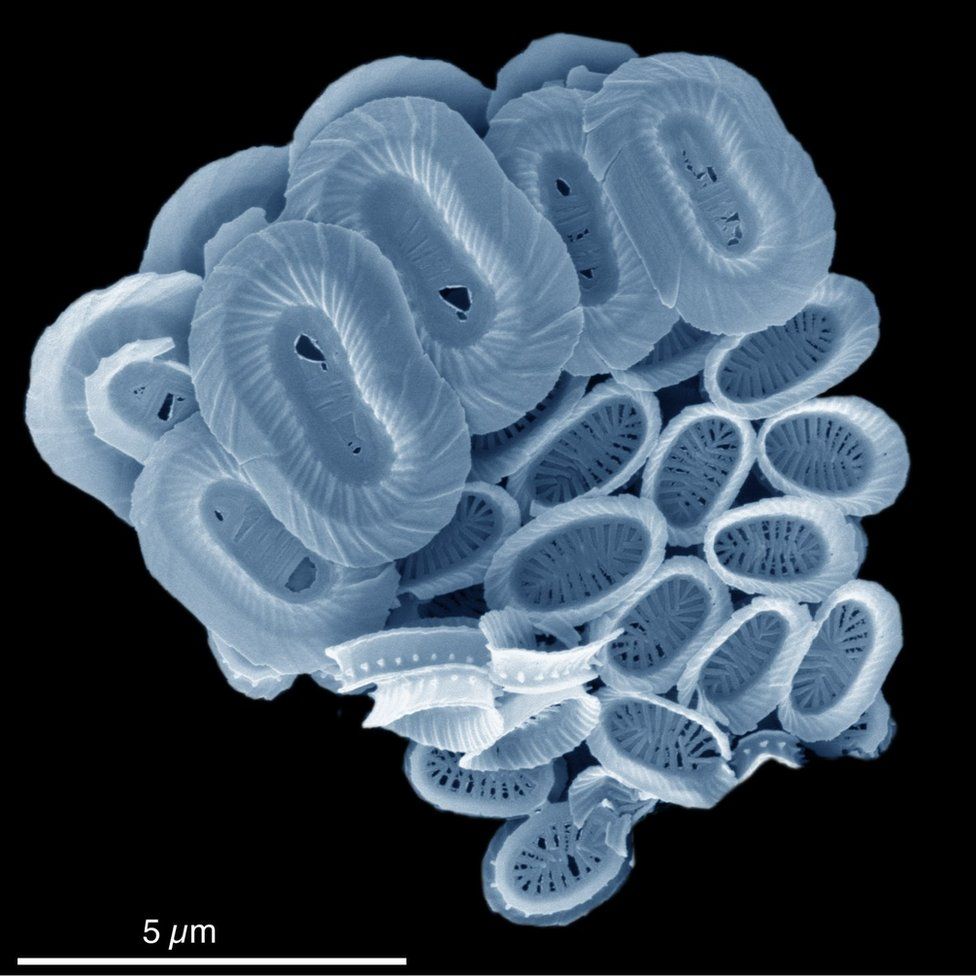Plankton named after BBC Blue Planet series
- Published

A type of plankton described as part of "the beating heart" of the oceans has been named after the BBC's Blue Planet series.
The tiny plant-like organism is regarded as a key element of the marine ecosystem.
Scientists at University College London (UCL) bestowed the honour on Sir David Attenborough and the documentary team.
It's believed to be the first time a species has been named after a television programme.
Sir David joked: "I'm not sure about the likeness!"
A single-celled algae, the plankton was collected in the South Atlantic but is found throughout the world's oceans.
It will now be officially known as Syracosphaera azureaplaneta, the latter translating from the Latin as 'blue planet'.
Sir David received the honour during a visit to UCL to open the newly refurbished Earth Science department, he said it was "a great compliment" and he was delighted that it would help raise awareness of the importance of plankton to the oceans.
"If you said that plankton, the phytoplankton, the green oxygen-producing plankton in the oceans is more important to our atmosphere than the whole of the rainforest, which I think is true, people would be astonished.
"They are an essential element in the whole cycle of oxygen production and carbon dioxide and all the rest of it, and you mess about with this sort of thing and the echoes and the reverberations and the consequences extend throughout the atmosphere."
The Blue Planet plankton is only about 10 microns across - the diameter of a typical human hair is about seven times greater.
It only lives for a few days but in that brief time creates shapes of incredible intricacy and beauty.
Looking at microscope images of the plankton, Sir David joked: "I'm not sure about the likeness but it's lovely… they're stunning, they're beautiful."
About a dozen different species have been named after the naturalist and presenter himself - including a rare tropical butterfly, a flightless Indonesian weevil and an armoured prehistoric fish whose fossil was found in Western Australia.
Others have been named in honour of celebrities - a horse fly after the singer Beyonce, a lemur for comedian John Cleese and a tree frog after Prince Charles.
Brazilian scientists named a bee after a catchphrase from a TV show.
But the Blue Planet plankton is thought to be the first example of a species given its name out of respect for a documentary series.
James Honeyborne, executive producer of Blue Planet 2, said: "Phytoplankton may be tiny but they are the basis of all life in the ocean - feeding everything from baby fish to great whales - and they help keep our seas, and indeed our whole planet healthy.
"It's a great honour for everyone in our wider Blue Planet II team: our filmmakers, camera operators, associated scientists and conservationists, explorers and support teams, to be associated with such an impactful form of life."
Prof Paul Bown of UCL said plankton played a vital role in the ocean, supporting the lives of much better known creatures.
"In terms of the link to the Blue Planet series, we felt they were the unseen stars of the series - hidden in plain view because of their minuscule size - but representing the beating heart of the oceans, providing food and pumping carbon from the shallow ocean to the deep-sea," he said.
He also said that because they create a hard covering "they form a constant rain of carbonate to the seafloor and form oceanic deep-sea ooze".
That allows scientists to study an "archive" of information locked in layers of rock on the sea floor.
"We therefore have an amazingly complete fossil record stretching back 220 million years to the Triassic," Prof Bown said, which allows scientists to study major upheavals in the past such as extinction events.
As he leant towards an image of the Blue Planet plankton, Sir David said admiringly: "Why that's not made by a modern jeweller I have no idea…"
Follow David on Twitter.